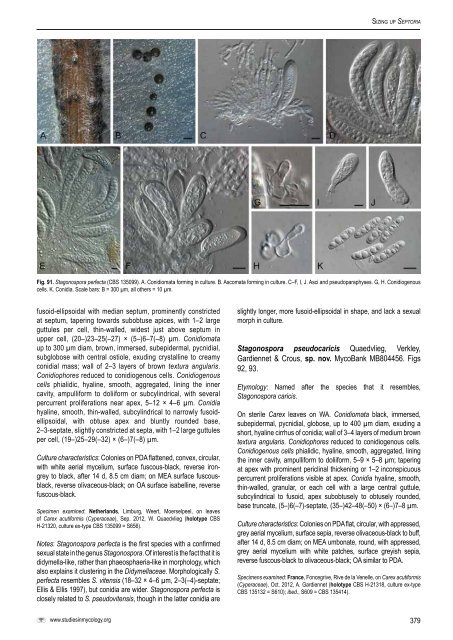Phytopathogenic Dothideomycetes - CBS - KNAW
Phytopathogenic Dothideomycetes - CBS - KNAW
Phytopathogenic Dothideomycetes - CBS - KNAW
You also want an ePaper? Increase the reach of your titles
YUMPU automatically turns print PDFs into web optimized ePapers that Google loves.
Sizing up Septoria<br />
Fig. 91. Stagonospora perfecta (<strong>CBS</strong> 135099). A. Conidiomata forming in culture. B. Ascomata forming in culture. C–F, I, J. Asci and pseudoparaphyses. G, H. Conidiogenous<br />
cells. K. Conidia. Scale bars: B = 300 µm, all others = 10 µm.<br />
fusoid-ellipsoidal with median septum, prominently constricted<br />
at septum, tapering towards subobtuse apices, with 1–2 large<br />
guttules per cell, thin-walled, widest just above septum in<br />
upper cell, (20–)23–25(–27) × (5–)6–7(–8) µm. Conidiomata<br />
up to 300 µm diam, brown, immersed, subepidermal, pycnidial,<br />
subglobose with central ostiole, exuding crystalline to creamy<br />
conidial mass; wall of 2–3 layers of brown textura angularis.<br />
Conidiophores reduced to conidiogenous cells. Conidiogenous<br />
cells phialidic, hyaline, smooth, aggregated, lining the inner<br />
cavity, ampulliform to doliiform or subcylindrical, with several<br />
percurrent proliferations near apex, 5–12 × 4–6 µm. Conidia<br />
hyaline, smooth, thin-walled, subcylindrical to narrowly fusoidellipsoidal,<br />
with obtuse apex and bluntly rounded base,<br />
2–3-septate, slightly constricted at septa, with 1–2 large guttules<br />
per cell, (19–)25–29(–32) × (6–)7(–8) µm.<br />
Culture characteristics: Colonies on PDA flattened, convex, circular,<br />
with white aerial mycelium, surface fuscous-black, reverse irongrey<br />
to black, after 14 d, 8.5 cm diam; on MEA surface fuscousblack,<br />
reverse olivaceous-black; on OA surface isabelline, reverse<br />
fuscous-black.<br />
Specimen examined: Netherlands, Limburg, Weert, Moerselpeel, on leaves<br />
of Carex acutiformis (Cyperaceae), Sep. 2012, W. Quaedvlieg (holotype <strong>CBS</strong><br />
H-21320, culture ex-type <strong>CBS</strong> 135099 = S656).<br />
Notes: Stagonospora perfecta is the first species with a confirmed<br />
sexual state in the genus Stagonospora. Of interest is the fact that it is<br />
didymella-like, rather than phaeosphaeria-like in morphology, which<br />
also explains it clustering in the Didymellaceae. Morphologically S.<br />
perfecta resembles S. vitensis (18–32 × 4–6 µm, 2–3(–4)-septate;<br />
Ellis & Ellis 1997), but conidia are wider. Stagonospora perfecta is<br />
closely related to S. pseudovitensis, though in the latter conidia are<br />
slightly longer, more fusoid-ellipsoidal in shape, and lack a sexual<br />
morph in culture.<br />
Stagonospora pseudocaricis Quaedvlieg, Verkley,<br />
Gardiennet & Crous, sp. nov. MycoBank MB804456. Figs<br />
92, 93.<br />
Etymology: Named after the species that it resembles,<br />
Stagonospora caricis.<br />
On sterile Carex leaves on WA. Conidiomata black, immersed,<br />
subepidermal, pycnidial, globose, up to 400 µm diam, exuding a<br />
short, hyaline cirrhus of conidia; wall of 3–4 layers of medium brown<br />
textura angularis. Conidiophores reduced to conidiogenous cells.<br />
Conidiogenous cells phialidic, hyaline, smooth, aggregated, lining<br />
the inner cavity, ampulliform to doliiform, 5–9 × 5–8 µm; tapering<br />
at apex with prominent periclinal thickening or 1–2 inconspicuous<br />
percurrent proliferations visible at apex. Conidia hyaline, smooth,<br />
thin-walled, granular, or each cell with a large central guttule,<br />
subcylindrical to fusoid, apex subobtusely to obtusely rounded,<br />
base truncate, (5–)6(–7)-septate, (35–)42–48(–50) × (6–)7–8 µm.<br />
Culture characteristics: Colonies on PDA flat, circular, with appressed,<br />
grey aerial mycelium, surface sepia, reverse olivaceous-black to buff,<br />
after 14 d, 8.5 cm diam; on MEA umbonate, round, with appressed,<br />
grey aerial mycelium with white patches, surface greyish sepia,<br />
reverse fuscous-black to olivaceous-black; OA similar to PDA.<br />
Specimens examined: France, Foncegrive, Rive de la Venelle, on Carex acutiformis<br />
(Cyperaceae), Oct. 2012, A. Gardiennet (holotype <strong>CBS</strong> H-21318, culture ex-type<br />
<strong>CBS</strong> 135132 = S610); ibed., S609 = <strong>CBS</strong> 135414).<br />
www.studiesinmycology.org<br />
379

















